联吡啶配位配合物:化学、成键及应用
IF 20.3
1区 化学
Q1 CHEMISTRY, INORGANIC & NUCLEAR
引用次数: 0
摘要
联吡啶是一类灵活的螯合配体,由于其能够建立稳定的螯合配体,在配位化学中取得了显著的里程碑。联吡啶(CCBs)配位配合物具有更好的稳定性、更大的溶解度、更好的电学和物理化学特性,以及与传统配体不同的选择性,使其在光化学、材料科学、催化等领域具有广泛的应用前景。取代基的组成显著影响它们的配体和电子特性,使它们具有特殊的用途。可调的空间和电子特性使CCBs成为均相和多相催化的通用材料。它们还广泛用于制备传感器、光伏器件和有机发光二极管(oled)。CCBs在治疗学和MRI(磁共振成像)方面显示出潜在的应用。它们已广泛应用于癌症治疗、光疗和药物输送系统。ccb是在光照下(即光催化),二氧化碳还原和转化为有价值的产品,以及有毒污染物,化学品和气体的传感污染物的恶化的理想候选者。CCBs由于其螯合和成膜能力而显示出优异的缓蚀性能。值得注意的是,适当的定制ccb可以帮助设计自愈腐蚀防护材料。本文探讨了CCBs的合成、化学及其在材料科学、催化、医学、环境和表面保护等方面的应用。本文还讨论了在不同科学和工程学科中使用CCBs的合成、表征和应用的挑战和机遇。本文章由计算机程序翻译,如有差异,请以英文原文为准。
Coordination complexes of Bipyridines (CCBs): Chemistry, bonding and applications
Bipyridines, a flexible class of chelating ligands, have attained a remarkable milestone in coordination chemistry because of their capacity to establish stable chelating coordination complexes. Better stability, greater solubility, improved electrical and physiochemical characteristics, and selectivity distinguish coordination complexes of bipyridines (CCBs) from traditional ligands and make them excellent candidates for various applications in photochemistry, materials science, and catalysis, among other domains. The substituents' composition significantly impacts their ligand and electronic characteristics, making them for particular purposes. The tunable steric and electronic properties make CCBs versatile materials for homogeneous and heterogeneous catalysis. They have also been extensively used in preparing sensors, photovoltaic devices, and organic light-emitting diodes (OLEDs). CCBs manifest potential applications in therapeutics and MRI (magnetic resonance imaging). They have been extensively used in cancer treatment, phototherapy, and drug delivery systems. CCBs are ideal candidates for the deterioration of pollutants on illuminated exposure (i.e., photocatalysis), CO2 reduction and conversion into valuable products, and sensing of toxic contaminants, chemicals, and gases. CCBs reveal excellent corrosion inhibition properties due to their chelate and film-forming abilities. Noticeably, suitable tailoring of the CCBs can help design self-healing corrosion protective materials. The present article explores the synthesis, chemistry, and applications of CCBs in materials science, catalysis, medicine, environments, and surface protection. This article also discusses the challenges and opportunities of using synthesis, characterization, and applications of CCBs in different science and engineering disciplines.
求助全文
通过发布文献求助,成功后即可免费获取论文全文。
去求助
来源期刊

Coordination Chemistry Reviews
化学-无机化学与核化学
CiteScore
34.30
自引率
5.30%
发文量
457
审稿时长
54 days
期刊介绍:
Coordination Chemistry Reviews offers rapid publication of review articles on current and significant topics in coordination chemistry, encompassing organometallic, supramolecular, theoretical, and bioinorganic chemistry. It also covers catalysis, materials chemistry, and metal-organic frameworks from a coordination chemistry perspective. Reviews summarize recent developments or discuss specific techniques, welcoming contributions from both established and emerging researchers.
The journal releases special issues on timely subjects, including those featuring contributions from specific regions or conferences. Occasional full-length book articles are also featured. Additionally, special volumes cover annual reviews of main group chemistry, transition metal group chemistry, and organometallic chemistry. These comprehensive reviews are vital resources for those engaged in coordination chemistry, further establishing Coordination Chemistry Reviews as a hub for insightful surveys in inorganic and physical inorganic chemistry.
 求助内容:
求助内容: 应助结果提醒方式:
应助结果提醒方式:


